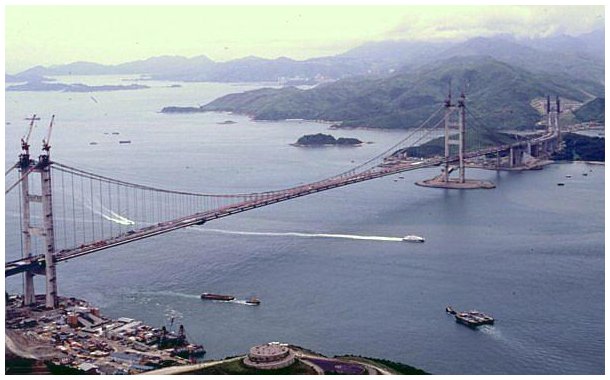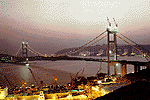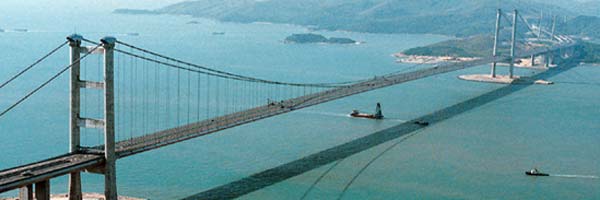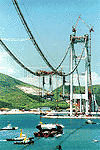


.
 |

|
 |
 |
|
 |
 |
 |
|
 |
The Tsing Ma Bridge, which spans 1377m across the busy Ma Wan Channel, is the second longest bridge in the world after the Humber Bridge in Britain. However, it is the longest bridge that carries both motorway and railway.The Tsing Ma Gigantic Bridge stretching from Tsing Yi Isle to Ma Wan (Bay), 22,000 meters long, is the longest suspension bridge for both vehicle and railway purposes in the world. It was open to traffic in 1997, linking Landau Island and the urban districts. Parking is prohibited on the Tsing Ma Gigantic Bridge. The Tsing Yi Trunkroute Viewing Terrace to the northwest of Tsing Yi Isle and the Visiting Guest Centre are places for watching and familiarizing with the Tsing Ma Gigantic Bridge with entertainment. The model, pictures and the structure of the Tsing Yu trunkroute are on display in the Visiting guest Centre. From the Scenery Viewing Terrace, one can see the Ting Kau Bridge, Linking Tsing Yi and Tsuen Wun, totaling 1178 metres long, the longest triplex-towered shape cable bridge of the world. Linking Tsing Yi and Lantau's transportation, another bridge known as Kap Shui Man Bridge, 1670 meters long, is also the longest hoisting cabled bridge providing for both vehicle traffic and railway transportation. These three bridges have been listed as the world's "Three Mosts". The expenditure for the engineering construction of the three bridges is also an astronomical figure.
There are Five Major Componentsin the Construction of the Tsing Ma Bridge:
(1) Foundations and the construction of the bridge tower - one tower located on Tsing Yi side and the other on a man-made island 120 m from the coast of Ma Wan Island. Both towers are 206m above sea level and founded on relatively shallow bedrock. The towers are two-legged with trusses at intervals, in the form of portal beam design. The legs were constructed with high-strength concrete of 100 MPa strength, using a slipform system in a continuous operation.
(2)Anchorages - the pulling forces in the main suspension cables is taken up by large gravity anchorages located at both ends of the bridge. They are massive concrete structures deeply seated on bedrock on the landside of Tsing Yi and Ma Wan island. The total weight of concrete used in the two anchorages is about 300,000 tonnes.
(3) Main cables - The cables were constructed by an aerial spinning process. The process involved drawing wires from a constant-tension supply, and pulling loops of these wires from one anchorage to the other, passing a 500-tonne cast-iron saddle on top of each bridge tower seating the cable. A total of 70,000 galvanised wires of 5.38 mm diameter were placed and adjusted to form the 1.1 m diameter main cable.
(4) Suspended deck - The steelwork for the deck structure was fabricated in Britain and Japan. After delivery, they were further processed and assembled in Dongguan of China into standard deck modules. A total of 96 modules, each 18 m long and about 480 tonnes in weight, were prepared. These deck modules were brought to the site by specially designed barges and raised into the deck position by a pair of strand jack gantries that could manoeuvre along the main cable.
(5)5. Approach span on Tsing Yi side - similar in form and cross-section to the suspended deck, but the approach span was supported on piers instead of cable-support. The first span was assembled on the ground and raised into position using strand jacks. Further erection then proceeded in cantilever in smaller sections, using derrick cranes stationed on the deck level. An expansionjoint which allowed for a maximum thermal movement of 850 mm was also provided and located inside the approach span section.
The Tsing Ma Bridge was designed to carry two three-lane carriageways on the upper deck and two railway tracks on the lower deck. There are also two sheltered single-lane carriageways on the lower deck for maintenance access and as backup for traffic during typhoons when wind speed is still within acceptable limits. The construction cost of Tsing Ma bridge is $7.14 billion and the actual completion time was 57 months.
By St.Paul's Secondary School
F.2A Season Ho (14)
Computer Homework
Chosen Topic: (4) Travels in a city
Title: Welcome to my Homeland - Hong Kong
e-mail address: [email protected]
My first Homepage: http://welcome.to/seasonho
My second Homepage: http://welcome.to/season_world